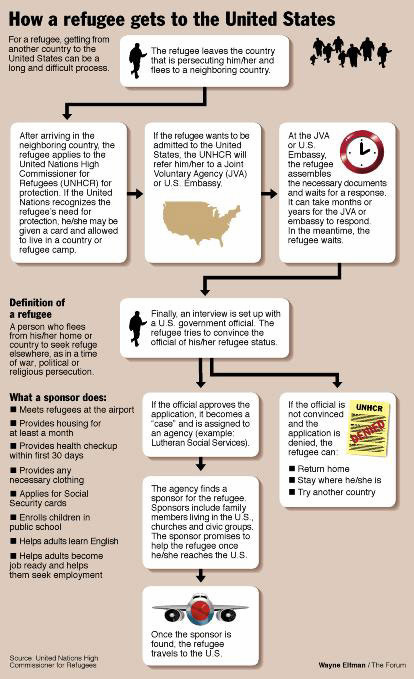The first part of this three-part series explained what the causes of the Syrian Refugee Crisis are and where the crisis stands now. The second portion of this series will explore the process a Syrian refugee must go through to receive asylum in the United States. This is important information for all of us to know because of the confusion, lack of information, and fear associated with allowing refugees from this war-torn area into our countries. The intent of this article is to give a clear and unbiased overview of what a Syrian refugee must go through to receive asylum in the United States. This information could also be informative when discussing how, if, and why we should welcome refugees into our communities.
How do they apply?
All refugees apply for asylum through the United Nations High Commission for Refugees (UNHCR). The UNHCR is an international organization under the United Nations that protects and assists refugees. Under UNHCR guidelines, an applicant may qualify for resettlement in another country if: (1) a well-founded fear of persecution based on race, religion, nationality, membership of a particular social group or political opinion can be demonstrated; (2) the applicant is outside of his or her country of nationality; and (3) the applicant is unable or unwilling to avail himself of the protection of that country. If such a person does qualify for asylum under the UNHCR’s standards, then that person will be referred to a third country for resettlement.
If that third country is the United States, the refugee must apply with the federal Resettlement Support Center and go through a rigorous 18-24 month screening process. During the rigorous screening process, officials investigate refugees to ensure the refugee’s story is legitimate and that the refugee will not pose a threat to the health or safety of the United States. The screening involves the participation of the U.S. State Department, the Department of Homeland Security (DHS), the Defense Department, the National Counterterrorism Center, and the FBI. These agencies double-check the refugee’s personal biographical statement and use biometric information to ensure the person’s story and identity are legitimate. Moreover, these agencies check for connections to known bad actors, outstanding warrants, and other information related to whether the person is a potential security risk. Refugees are also interviewed by DHS agents and medically tested for communicable diseases. In sum, seeking asylum is the most difficult and stringent way for a person to enter the United States.
What is different about the process for Syrian refugees?
For Syrian refugees the process goes one step further by requiring them to go through the Syrian Enhanced Review process where the refugee applicant’s file is further scrutinized for accuracy and veracity. The U.S. government added this extra step especially for Syrian refugees “due to the circumstances in Syria.” These circumstances obviously include the war, but also the fact that ISIS operatives are fighting in Syria. As many have observed, the biggest fear in allowing Syrian refugees into the country is the fear that an ISIS operative might pose as a refugee and sneak through the system and commit an act of terrorism in the United States. To prevent that possibility, the U.S. government created the Syrian Enhanced Review. Today, Syrian refugees are subject to the highest level of security checks of any category of traveler to the United States. If there is any doubt about the veracity of an applicant’s story, the applicant will not be admitted.
What next?
For the first several years of the Syrian Civil War the United States accepted a very small number of refugees. Up until last year, the United States received approximately 2,200 Syrian refugees while over 1 million fled to Lebanon. Last year, President Obama promised to increase the number of refugees to 10,000 by the end of the fiscal year (September 2016). That goal was reached in August 2016.
The United States is in a difficult situation. In a post 9/11 society, where fears of domestic and international terrorism abound, we must weigh the concern for safety with our duty to welcome and care for refugees. Indeed, welcoming refugees is a large part of the legacy of the United States. Given the dire circumstances and the difficulty in passing the test compared to the likelihood of a terrorist sneaking through, one must wonder if the screening process is too stringent? The high standards do screen out threats to public safety while nearly guaranteeing that any Syrian refugee that makes its way to the United States is not a threat. When Syrian refugees do pass the high standards set before them, what happens to them next and how can we be a part of it? That question will be answered in the next and final post, addressing what a refugee goes through when he or she finally makes it to the United States and what we, especially those of us in Colorado, can do to help.


